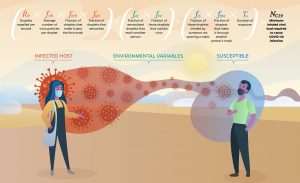The Contagion Airborne Transmission inequality can be used to calculate the risk of airborne transmission of respiratory infections. Transmission occurs if the droplets expelled per second times the average number of virus particles per droplet, times the fraction of droplets that make it past the face mask, times the fraction of droplets that aerosolize, times the fraction of aerosolized droplets that reach another person, times the fraction of those droplets that contain virus, times the fraction of droplets inhaled by someone not wearing a mask, times the fraction of droplets that make it through another person’s mask, times the duration of exposure is greater than or equal to the minimum inhaled viral load required to cause infection. Graphic courtesy of Marissa Lanterman/Johns Hopkins University
